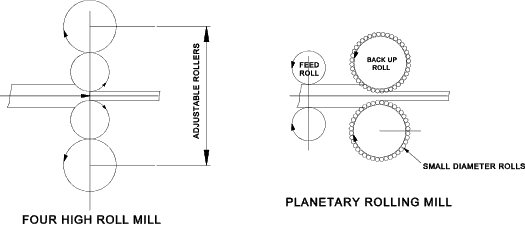|
|
|
Primary Processes Forging Processes
|
Introduction Forging dates back to ancient times and was associated with the village blacksmith.
Virtually all ductile metals may be forged by first preheating the work piece to a forging temperature.
The work piece can be a billet, a wrought bar, a cast or sintered ingot etc. The forging process can
then be completed by hammering the work piece to the desired shape.
1) Open Die/hammer or smith forging Open die (smith forgings) are made by using steam or air hammers or presses in conjunction
with blacksmith tools or flat type dies. There is little lateral confinement of the work piece.
The desired shape is obtained by manipulating the workpiece between blows. This process is based on hammering the work pieces into into the desired shape by means of
closing dies. The hammering or pressing is performed, respectively, by a mechanical or hydraulic press.
Small and medium sized forgings are generally made in presses ranging in capacity from 500 to 10000 te. In this process a slow squeezing action is used to form the metal. The slow squeezing action
penetrates the entire workpiece allowing the process to be used for the forging of large objects. Press forges are made
in sizes of up to 50,000 te. Upt to 15000 te the presses may be mechanical or hydraulic. The larger presses
are always hydraulically powered. This process uses barstock which is heated at the end which is being forged. The bar is gripped
in the fixed half of a die so that the length of material being forged projects. The forging blow is delivered by a moving die.
Simple shapes are produced in a single stage but more complicated shapes require multiple stages. Swaging is the forging method used for sizing, pointing, tapering, and otherwise shaping of the ends of rods or tubing. Rolling Rolling is the most important metal working process and can be performed on either hot or cold metal. Material is passed between cast of forged steel rolls which compress it and move it forward. Rolling is a economical method of deformation if metal is required in long lengths of uniform cross section. Normal rolling achieves thickness reduction of about 2:1. Slabs and blooms.Ingots are first rolled into either rectangular slabs or square blooms which are produced as intermediate stages. In this rolling process the ingots are passed through the plain rolls repeatedly in one direction and then in the reverse direction at each stage the rolls are brought closer together. If square blooms are required the material is rotated through 90o between rolling operations. Plates Strips and Sections.The rolling process can be used to produce plates, strips and rolled sections including channels, Universal Columns angles sections etc. The plates and strips are generally formed using plain rolls. The rolls can bow which results in the plate being thicker at the middle. The rolls can be backed up in four high roll arrangements. with additional rolls to reduce this tendency.. Planetary rolling millsSmall diameter rollers are more effective than large ones in conveying rolling forces to deforming metal. Planetary mills take advantage of this principle. This process can achieve thickness reductions of up to 25:1 
|
Links Providing information on forging
|
|
Manufacturing Index
Primary Processes